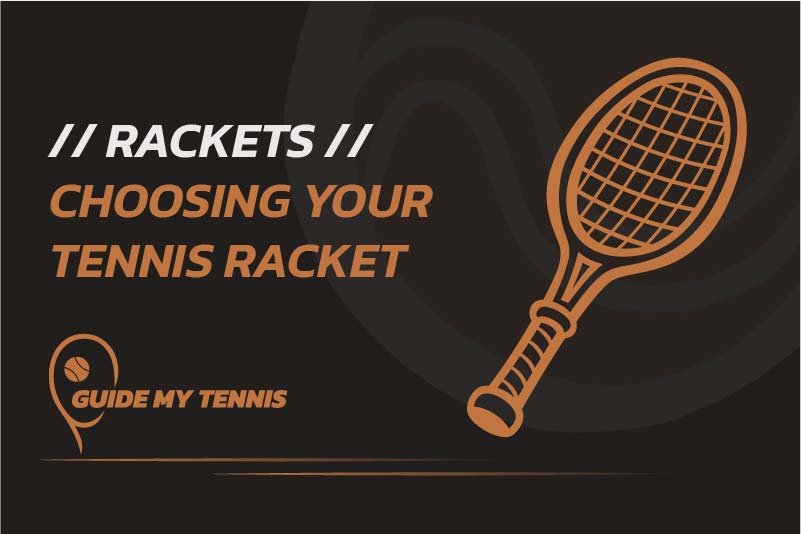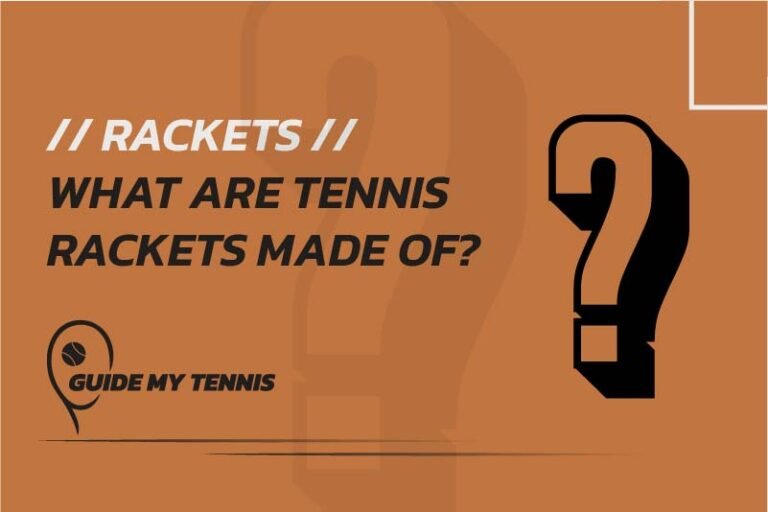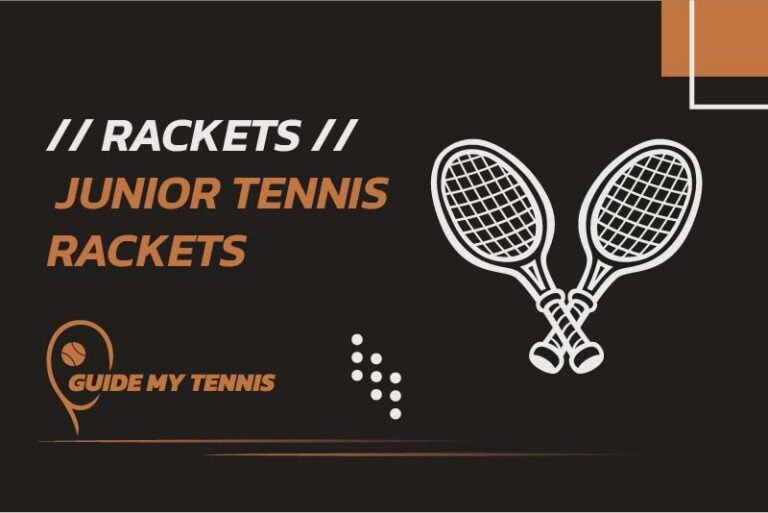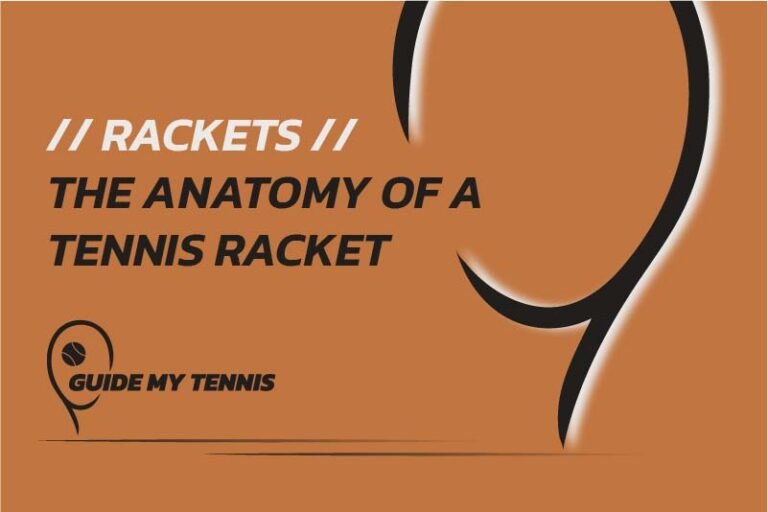How to Choose a Tennis Racket – A Detailed Buyer’s Guide
Discover Your Perfect Match: Ready to find your game-changer? Keep reading to uncover the secrets on how to choose a tennis racket that matches your play style and elevates your game to new heights.

Introduction: Elevate Your Tennis Experience
Welcome to the definitive guide on tennis rackets focusing on how to choose a tennis racket. Whether you’re a beginner aiming to make your mark or an advanced player looking to refine your game, the right tennis racket can be your greatest ally on the court. In this comprehensive tennis racket size guide, we’ll dive deep into everything you need to know about tennis rackets.
A Journey Through Time: The Evolution of Tennis Rackets
The tennis racket has undergone significant transformations, evolving from simple wooden frames to sophisticated equipment and materials designed to enhance every aspect of play. Understanding this evolution can help you appreciate the innovations that contribute to today’s game dynamics.
More often than not, when a tennis player is seeking information on how to choose a tennis racket, they sadly skip over the journey that the tennis racket took over the years.
The first tennis racket was invented around the 1870s, making the journey of the tennis racket around 150 years old. Old tennis rackets were constructed with different materials. This meant different racket specs and this undoubtedly left its mark on the different play styles that were adopted over the years.
Read the Guide My Tennis article on What are Tennis Rackets Made of? for a detailed exploration of tennis racket history and its impact on the game we all love.
Types of Tennis Rackets: Finding Your Match
When seeking how to choose a tennis racket, you need to know the difference between the different racket profiles. Here’s a categorical breakdown of the different types of tennis rackets and what’s recommended for the different skill levels.
- Power Rackets: Ideal for beginners looking for a boost in their swing.
- Spin Rackets: Ideal for both intermediate and advanced players seeking aggression
- Control Rackets: Perfect for advanced players seeking precision.
- Tweener Rackets: A balanced option for intermediates aiming for improvement.
Power Rackets
A power-oriented tennis racket is built to produce easy power. They tend to have a larger head size and a thicker frame. In addition to that, power rackets tend to be stiffer and are generally head-heavy or balanced. These characteristics provide a huge boost for power. Such rackets are generally favoured by tennis players who have a shorter groundstroke and need help with creating additional power.
Spin Rackets
The move to a heavy topspin playing style at the top of the game has created the modern player’s racket. These rackets are light and fast, offering mid-plus head sizes. Spin-friendly rackets are perfect for attacking the ball at an aggressive angle for maximum spin. The power level is similar (if not identical) to tweener rackets. Head sizes of modern players’ rackets are often right around 98-100 in2.
Control Rackets
A control-oriented tennis racket is ideal for those tennis players who have a fast groundstroke swing and are capable of creating power on their own, without any additional help. High-level club players, college team players and pros favour such tennis rackets. They have a smaller head size (85-97 in2) and tend to be a bit heavy (> 305 grams). Their thin beams are considered to be very flexible, resulting in a low-power racket.
Tweener Rackets
A tweener borrows some of the lightness and power of the power rackets and mixes it with some of the control of the player’s rackets. These rackets are often balanced anywhere from slightly head light to slightly head heavy and have mid-plus (98-104 square inches) heads. The power level typically ranges from low-medium to medium-high power, making them most appealing to intermediate through advanced players. Tweener rackets tend to be very spin-friendly thanks to possessing a light and fast feel combined with a healthy mid-plus head size.
Getting to Know the Racket: Tennis Racket Anatomy
A tennis racket is your only companion during a match. You want to be on the best of terms with your pal during the match. Having a tennis racket that fits your playing style is critical for succeeding in games.
You don’t want to have a tennis racket that is too light or too heavy right? And what about the head size? How does it affect you? These are only some of the questions that you should be asking.
When you are seeking information on how to choose a tennis racket that is suitable for you, make sure you’re aware of the different parts of the tennis racket.

Factors To Consider When Buying a Tennis Racket
The power and control-oriented profiles are the two extremes of a tennis racket’s profile. A racket which gives you more control has certain specifications that are completely different from a tennis racket that gives its user power. It’s good to note that other tennis racket profiles all derive from these two.
Let’s dive into the actual components that will serve as a guide to buying a tennis racket, and clear out any misconceptions you may have on how to choose a tennis racket.
#1 Head Size
The first element is the head size. A tennis racket can come in many different sizes. The head size is a heavyweight player when it comes to picking out your tennis racket. The head size has a big impact on your game. Even a 98 in2 has a different feel than a 105 in2, despite both falling under the label of mid-plus.
There are a total of three different ranges that a head size can be classified as:
- Midsize – 85-97 in2 / 550-625 cm2
- Mid-Plus – 98-105 in2/ 630-680 cm2 (the most common size)
- Oversized – 106-135 in2/ 685-870 cm2
When the ball comes into contact with the strings on your tennis racket, the ball bounces. This is generally known as a trampoline effect. Your strings act as a trampoline and the larger the head size, the greater this trampoline effect, because the ball is able to sink deeper into the racket, thus creating more power.
Therefore, big head size = more power.
On the other hand, a bigger head size sacrifices consistency and precision and can feel too bulky for manoeuvrability. That is why tennis players who favour control often go for the smaller head sizes because such rackets are easier to manoeuvre and provide more precision.
So, small head size – more control.
#2 Racket Weight
This is another element that has a big impact on your game.
A tennis racket’s weight is generally classified without strings. Therefore, the weight will increase once the tennis racket is strung. The weight is a crucial aspect of the racket, and if the racket is too light or too heavy, then you will not play at your best.
Similar to the head size, the weight of a tennis racket can be classified as follows:
- Lightweight: 9 – 9.7oz / 255 – 280g
- Medium Weight: 9.8 – 11oz / 280 – 305g
- Heavyweight: 11oz / 305g or heavier
Keep in mind that a heavy tennis racket has more power and is more stable, especially in the big shots. Advanced players tend to go for a heavier racket.
On the other hand, a lighter racket frame is more suitable for beginners and is less strenuous on the arm.
#3 Racket Length
The length of a tennis racket is generally measured from the butt of the handle to the tip of the tennis racket’s frame – literally from edge to edge.
The most common length is 27 inches, but the length can be a bit higher or lower.
The longer the tennis racket is, the greater its reach but tends to be heavier and bulkier.
#4 Balance
On your how to choose a tennis racket journey, you cannot forget the balance. The balance of a tennis racket simply refers to the weight distribution. How is the weight distributed throughout the tennis racket frame? Although important, this small detail is very often overlooked.
The balance is recorded while the racket is unstrung. It can be defined as the distance in mm between the butt cap and the balance point.
- Head-Light: A head-light tennis racket has its balance shifted towards the handle of the racket (<330 mm)
- Even Balance: An evenly balanced racket has its weight distributed evenly. (330 mm – 350 mm)
- Head-Heavy: A head-heavy tennis racket has its centre of gravity shifted towards the head of the racket. (>350 mm)
A general rule of thumb is the following:
- Baseliners tend to favour head-heavy tennis rackets.
- Net players tend to favour head-light tennis rackets.
#5 Swingweight
The fifth element for this how to choose a tennis racket buyer’s guide is the swingweight. Many club players tend to overlook this specification. However, swing weight is a factor that can impact how you play. Swingweight can be simply defined as the weight value that the racket has when it is swung in the air. Keep in mind, that a tennis racket’s size, unstrung weight and balance heavily affect the swing weight.
Note that tennis rackets which are longer and/or have a head-heavy frame have a higher swing weight than tennis rackets with a shorter / head-light frame – even if they possess the same unstrung weight.
A tennis racket with a higher swing weight value is going to feel heavier and more difficult to manoeuvre on the court. It might even exhaust your arm and can cause problems such as tennis elbow. However, a higher swing weight means more power and stability for your shots.
#6 Frame Stiffness
The next thing you have to look out for when seeking how to choose a tennis racket is the frame stiffness. The stiffness of a tennis racket is a personal thing. You see, the stiffness of a tennis racket affects the tennis racket’s power, control and comfort when hitting the ball.
Every single tennis player perceives racket stiffness in a different way. Even their choice of strings impacts the stiffness of the racket. To learn more about the various types of strings available, click here
The stiffness of a tennis racket is measured using the RA index and there are 4 classes of stiffness:
- Low Stiffness: RA score between 55-60
- Medium Stiffness: RA score between 61-65 Medium stiffness
- High Stiffness: RA score between 66-70
- Very High Stiffness: RA score between 71-75
Do note that if you suffer from any pain in your arm, elbow and/or shoulder, you should opt for a tennis racket that has a low stiffness index.
But, ultimately, what you need to remember is the following:
High racket stiffness = More power.
Low racket stiffness = More control and comfort
#7 Beam
The 7th factor to consider when seeking how to choose a tennis racket is the beam of the racket. This refers to the thickness of the racket’s head.
The thicker the beam is, the stiffer the racket becomes and vice versa.
Players who constantly seek to deliver more power on their shots tend to prefer a thicker beam. However, this boost in power comes by sacrificing control and comfort.
A thinner beam absorbs more energy and is more flexible than a thick-beamed racket. Hence, the comfort of the racket is improved since less shock goes through the arm. So if any of you suffer from tennis elbow, a thinner beam might be more suitable for you.
When evaluating the beam of a tennis racket, you must also consider its shape. Is it rectangular (box beam) or roundish (elliptical beam)? The difference between the two (apart from their shape) is that a box beam is stiffer than a beam that takes on an elliptical shape.
This is an additional detail, but hey, I am keeping my word and giving you what’s stated – a comprehensive guide on how to choose a tennis racket to fit your style!
#8 String Pattern
The 8th component for this how to choose a tennis racket buyer’s guide is the string pattern. The string bed of a tennis racket also plays an important part in the way you play. A tennis racket generally adopts either one of these string patterns, however, there are more patterns that one can adopt:
- 16 x 18
- 16 x 19
- 18 x 20
Note that when we say 16 by 19, in that order, we are referring to 16 mains / vertical strings with 19 cross / horizontal strings.
The string patterns 16 x 18 and 16 x 19 are referred to as open string patterns. These are regarded as ‘open’ since the strings have a lot of space between one and the other. Open string beds are great for those players who like hitting deep, powerful shots with a lot of spin.
On the other hand, a string pattern comprised of 18 x 20 is referred to as a dense string pattern. The word ‘dense’ is used as the space between the strings is limited. Dense string beds tend to be preferred by players who hit the ball flat; but overall, a dense string bed is still considered to be spin-friendly.
If you are seeking more information about the different strings you can use and what strings are best for comfort, power and spin, I have the perfect read for you!
So just to break it down and make it easier for you to understand, an open string bed is more powerful, easier to put spin on those shots and is somewhat less stiff.
On the other hand, a dense string bed gives more control and precision but is firmer.
#9 Choosing the Right Grip Size
The importance of grips cannot be stressed enough when learning how to choose a tennis racket. It’s a topic that is covered in great detail in this tennis racket grip size guide.
Here’s a quick tennis racket grip size guide to get yourself familiar with choosing the right tennis racket with the correct grip size:
| American | European |
|---|---|
| 4″ | Grip Size 0 |
| 4 1/8″ | Grip Size 1 |
| 4 1/4″ | Grip Size 2 |
| 4 3/8″ | Grip Size 3 |
| 4 1/2″ | Grip Size 4 |
| 4 5/8″ | Grip Size 5 |
First, you should hold your racket in an Eastern forehand grip and see whether the index finger of your non-hitting hand fits in the space between the edge of your fingers and your palm. If there is space, the grip is too big and if there is not enough room, then the grip is too small.
Note that if at any point you are unsure about the right grip size, you can always go for the smallest of the two, and then add an overgrip to increase the grip size. Remember that an overgrip is likely to give you a slight increase between the ranges of 1.3 mm and 1.6 mm.
Recently, players seem to be opting for a smaller grip size as many find that this enhances their ability to generate more spin. But always choose according to what you find comfortable and what works for you.
How to Choose a Tennis Racket for Beginner Tennis Players?
If you are just starting out in tennis and are looking to purchase your first tennis racket, you should get one that is easy to play with. Your main aim is to put the ball in, not to hit powerful spin-heavy shots. Your priority for now is to focus on building your technique.
As a result, my recommendation to you is to get a tennis racket that has a large head size and is light. This will help you hit the ball consistently and play effectively without wearing out your arm.
How to Choose a Tennis Racket for Intermediate Tennis Players?
As an intermediate tennis player, you should now have a good idea of how to hit your groundstrokes with the right technique. It is likely that you now want to add more power to your shots, and possibly even a little bit of spin.
If that is the case, you should consider getting a racket that is a bit heavier and has a smaller head size. You can still use an oversized tennis racket, but looking at the mid-plus range won’t hurt you. Moreover, at this stage, you are likely to be familiar with how to generate your own power. As a result, looking at getting more control from your racket will also help you develop your skills further.
How to Choose a Tennis Racket for Advanced Tennis Players?
An advanced tennis player is one who can generate raw power and play with profound precision and control.
As a tennis player, you can now look at getting a tennis racket that has a medium to heavy weight frame and an even smaller head size. As an advanced player, it is suggested you step away from the oversized head size and opt for a mid-plus or midsize for more control. Now, as your level advances, you must not overlook other elements, such as stiffness, swing weight and the type of string that you choose to play with. In tennis, every detail counts!
Junior Tennis Rackets
And let’s not forget about our young champions! Junior tennis rackets are designed with the younger player in mind, balancing size, weight, and performance for the stars of tomorrow. This junior tennis rackets guide will help you identify the perfect racket for the budding tennis player in your family
One of the very first things you have to consider when picking out a junior tennis racket is that such rackets are categorised by length. This differs from adults’ tennis rackets since they are usually categorised by head size.
The second thing to keep in mind is that kids develop at an extremely fast pace, so the racket they may be using might be deemed incorrect in a few months. But fret not. Let’s see how to choose a tennis racket for junior players.
17-Inch Tennis Rackets
This is generally used by children aged between 2 and 4 years.
19-Inch Tennis Rackets
The slightly longer 19-inch tennis racket is commonly used by children aged between 4 and 5 years.
21-Inch Tennis Rackets
Adding with increments of 2, children aged between 5 and 6 years tend to use the 21-inch racket.
23-Inch Tennis Rackets
Children aged between 7 and 8 are the ones that make use of the 23-inch racket.
25-Inch Tennis Rackets
The 25-inch racket starts resembling more and more adults’ tennis rackets. The reason is that this will be 2 inches less than a normal adult-size tennis racket. Therefore, factors such as the tennis racket’s weight and the child’s skill will play a big part in choosing which 25-inch tennis racket you choose. A recreational child tennis player will tend to find a lighter 25-inch tennis racket more comfortable. On the other hand, a competitive child will require a heavier 25-inch racket. This is generally used by children aged between 9 and 10 years.
26-Inch Tennis Rackets
Just 1 inch less than a normal adult racket, the 26-inch tennis racket is used by children aged 11 and over. Skill and experience are pivotal in choosing a 25-inch and a 26-inch tennis racket. The latter will be heavier than the former and is generally preferred by competitive junior players. The 26 inch tennis racket aims to help the child transition to the adult-size tennis racket.
Keep in mind that the correct tennis racket for your junior buddy will also be impacted by his or her body type. Height may also play a part. The above is just a guide to the different junior tennis rackets. In this Junior Tennis Racket Size Guide, you will also find how to measure a tennis racket to fit the needs of your junior tennis mate.
Most Popular Tennis Racket Brands
With so many brands out there, choosing can feel overwhelming. But worry not! You can get familiar with the best tennis racket brands here. Each brand has its own unique strengths and technologies. Whether you’re looking for innovation, tradition, or something in between, there’s a brand that matches your needs.
You can’t complete your how to choose a tennis racket journey without reviewing the most popular tennis racket brands. Here’s a handpicked list of popular tennis racket brands and their respective racket ranges:
Wilson
The American brand is one of the most popular brands across multiple sports. It is behind the creation of the following 5 tennis racket families.
| Wilson Pro Staff | Power-oriented with great spin potential, ideal for modern baseliners. |
| Wilson Blade | Balanced and flexible rackets, great all-round for players of any level. |
| Wilson Ultra | Power oriented with great spin potential, ideal for modern baseliners. |
| Wilson Clash | Flexible, arm-friendly rackets suitable for players of all styles and abilities. |
| Wilson Burn | Spin-friendly rackets, great for heavy hitters looking for lots of spin. |
Babolat
Did you know that despite being founded in 1875, it has only been producing racket frames for the past 30 years? The French company has 3 different frames:
| Babolat Pure Aero | Control-oriented rackets designed for hard hitters with lots of spin. |
| Babolat Pure Drive | Incredible all-round rackets, designed for a perfect blend of power, spin and precision. |
| Babolat Pure Strike | Control oriented rackets designed for hard hitters with lots of spin. |
Head
The American company has been wielding a lot of tennis stars and prodigies since the 1960s. These include big names such as Novak Djokovic, Andre Agassi, Maria Sharapova, and Jannik Sinner. They have an extensive range of tennis rackets, ranging from easy to use rackets to advanced ones.
| Head Speed | The ultimate blend of control and power, these rackets are great dof intermediate to advanced players. |
| Head Radical | Rackets with a solid feel and plenty of control and power, they’re perfect for players of all abilities. |
| Head Gravity | Very flexible rackets with excellent control and feel, ideal for up-and-coming juniors and advanced players. |
| Head Prestige | Precision oriented rackets, ideal for intermediate and advanced players. |
| Head Extreme | Explosive rackets with lots of power and spin, ideal for big hitters that control the game from the baseline. |
| Head Instinct | Powerful rackets, ideal for players looking for extra power and spin on their shots. |
| Head Boom | Precision-oriented rackets, ideal for intermediate and advanced players. |
Yonex
The world knows about the power of Japanese cars, but sadly they don’t know enough about the cutting-edge tennis rackets that Yonex produces. The Japanese company produces tennis rackets with their trademarked Isometric Technology, giving their rackets a unique shape and feel. They focus on these 3 ranges:
| Yonex Ezone | Speed and spin-oriented rackets, perfect for modern baseliners. |
| Yonex Vcore | Heavy, Head Light and control-oriented rackets best suited to advanced players. |
| Yonex Percept | Heavy, Head Light and control oriented rackets best suited to advanced players. |
Tecnifibre
Wielding the Russian tennis star, Daniil Medvedev and the Polish ace, Iga Swiatek, Tecnifibre has quickly made a big name for itself. Here’s the tennis racket range that Tecnifibre produces:
| Tecnifibre TFight | Control and feel-oriented rackets, perfect for intermediate to advanced level players. |
| Tecnifibre TF40 | Control and feel oriented rackets, perfect for intermediate to advanced level players. |
| Tecnifibre TF-X1 | Powerful rackets that offer maximum stability, playability and comfort. |
| Tecnifibre Tempo | Designed for speed, precision, power and spin, these are great all-round rackets. |
Ready to Find Your Perfect Match?
Picking the right tennis racket can feel daunting, but remember, it’s a journey we’re on together. As your coach, I’m here to guide you every step of the way. Whether you’re looking for power, spin, control, or just getting started, there’s a racket out there waiting for you.
If you enjoyed this guide on How to Choose a Tennis Racket let me know!
Don’t hesitate to reach out with questions or for advice. And remember, the best way to find your perfect racket is to get out there and play. See you on the court!





